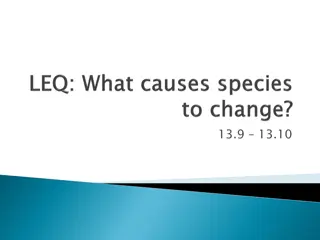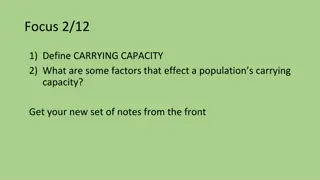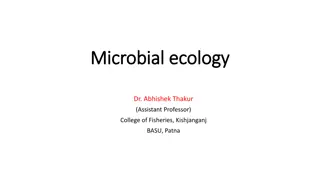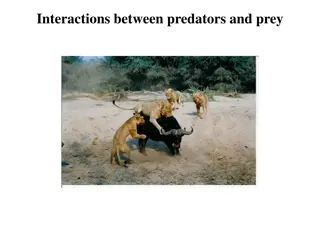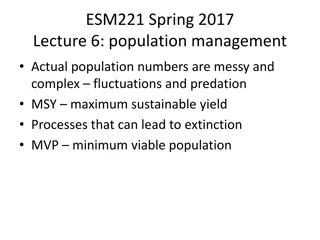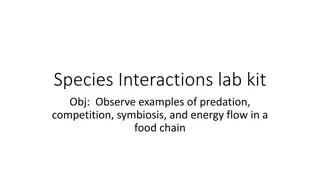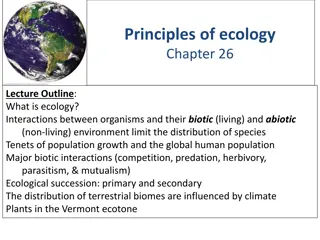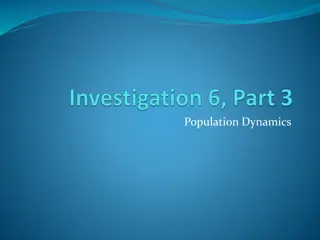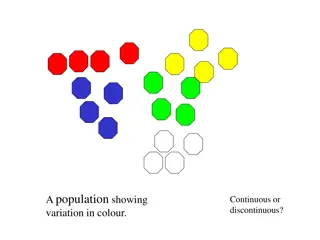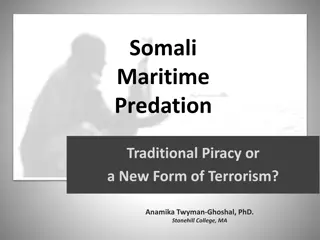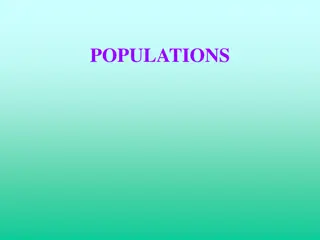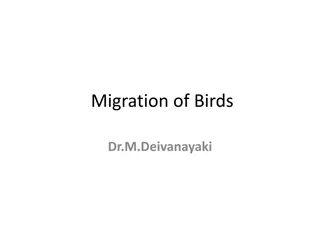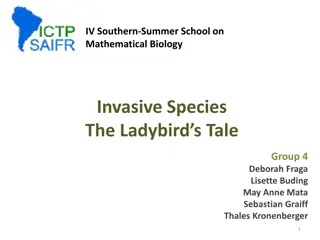Understanding the Paradox of Plankton and Biodiversity Correlates
The paradox of plankton challenges the theory that the number of species should match available resources, as seen in diverse plankton ecosystems. Explanations include resource partitioning, temporal and spatial heterogeneity, predation, adaptation to disturbance, and evolutionary processes. Biodive
3 views • 40 slides
Understanding Species Interactions and Predator-Prey Dynamics
Species interactions refer to the associations between different organisms that can be positive or negative, influencing the growth and evolution of populations. Predation is a key interaction where one organism hunts and feeds on another. In predator-prey dynamics, populations fluctuate in a cyclic
3 views • 36 slides
Understanding Evolutionary Mechanisms: Natural Selection, Genetic Drift, and Gene Flow
Exploring the forces behind evolutionary change, this content delves into natural selection, genetic drift, and gene flow. Examples such as the bottleneck effect, founder effect, and Amish population polydactylism are presented to illustrate how these mechanisms shape genetic diversity. The impact o
0 views • 14 slides
Interactions Among Species in Ecosystems
Understanding species interactions in ecosystems is vital for ecological balance. It involves concepts such as carrying capacity, niche occupancy, and symbiosis. Factors affecting a population's carrying capacity include resource availability, competition, predation, parasitism, and mutualism. Diffe
0 views • 21 slides
Understanding Microbial Ecology: Interactions and Associations in Ecosystems
Interactions of organisms in ecosystems play a crucial role in the functioning of microbial ecology. Dr. Abhishek Thakur explores symbiosis, mutualism, syntrophism, commensalism, predation, and parasitism, shedding light on how different organisms interact with each other and their physical environm
0 views • 9 slides
Understanding Animal Communities in Geography
Animal communities are formed by various species occupying the same habitat or microhabitat, interacting within a biological community. Each species has a unique ecological niche, influencing interactions like competition and predation. Communities consist of producers, herbivores, carnivores, and m
1 views • 9 slides
Exploring Community Ecology: Interactions in Ecosystems
Community ecology, as presented by Mr. Nitin A. Ghorpade, delves into the dynamics of species interactions within ecosystems. It covers concepts like communities, individualistic vs. interactive hypotheses, interspecific interactions, predation, parasitism, plant defenses against herbivores, and mor
0 views • 23 slides
Understanding Relationships Between Organisms in Nature
Explore the various relationships between organisms in nature, including intraspecific and interspecific interactions such as competition, predation, and parasitism. Learn how organisms compete for resources, hunt and protect themselves, as well as how parasites survive on host organisms. Delve into
2 views • 13 slides
Understanding Predator-Prey Interactions: Impacts and Equilibria
Explore the dynamics of predator-prey interactions, including what defines a predator, the impacts predators have on prey populations, and the equilibrium points in the Lotka-Volterra Predator-Prey model. Discover how predation plays a crucial role in regulating population densities and observe the
0 views • 36 slides
Interactions Among Living Things and Adaptations in Nature
Understanding the interactions among living things, such as competition, predation, and symbiosis, sheds light on how organisms adapt to their environments through natural selection. Each organism occupies a unique niche, defining its role in the ecosystem. Predation plays a crucial role in populati
0 views • 14 slides
Population Management and Sustainable Harvesting Strategies
Actual population numbers exhibit complex fluctuations influenced by predation and other factors. Understanding concepts like Maximum Sustainable Yield (MSY) and Minimum Viable Population (MVP) can help in managing populations effectively. The concept of MSY ensures the maximum harvest of a renewabl
0 views • 32 slides
Exploring Species Interactions in a Lab Setting
Discover examples of predation, competition, symbiosis, and energy flow in a food chain through interactive lab stations. From predator-prey relationships to mutualistic interactions, observe and learn about ecological dynamics in a hands-on environment.
0 views • 5 slides
Exploring Ecology: Interactions, Distribution, and Population Dynamics
Ecology delves into the relationships between organisms and their environment, understanding factors that limit species distribution, major interactions like competition and predation, as well as population growth patterns. This includes the influence of biotic and abiotic factors, ecological succes
0 views • 30 slides
Understanding Population Dynamics in Ecosystems
Exploring the concept of carrying capacity, examining real data from Mono Lake, comparing predictions to actual data, discussing biotic and abiotic limiting factors, and understanding how organisms can impact populations without direct predation. Dynamic ecosystems are constantly changing, as eviden
0 views • 13 slides
Population Dynamics in a Changing Environment
In this visual story, a population exhibits color variation in response to environmental factors such as food availability and predator pressure. The population faces challenges including predation, seasonal changes, and natural selection. Genetic mutations and adaptations play a role in the surviva
0 views • 24 slides
Understanding Somali Maritime Predation: Piracy or Terrorism?
Delve into the complexities of Somali maritime predation, questioning whether it falls under traditional piracy or is evolving into a new form of terrorism. Explore the distinct characteristics, international legal definitions, and policy implications surrounding this critical issue.
0 views • 19 slides
Understanding Population Dynamics and Adaptation in Ecological Systems
Population size and distribution are influenced by various factors such as competition, predation, migration, diseases, and natural disasters. Populations adapt to their environments to survive and reproduce, facing struggles like finding food, water, shelter, and protection against predators and di
0 views • 17 slides
Fascinating Insights into Bird Migration Patterns and Adaptations
Bird migration is a captivating natural phenomenon driven by factors such as food availability and daylight changes. Various species exhibit remarkable adaptations in physiology and behavior to undertake these long journeys, benefiting ecosystems and aiding in the dispersal of species. While migrati
0 views • 5 slides
Interactions between Ladybird Species in Controlling Aphid Populations
Aphids are pests that parasitize plants and can reproduce rapidly, leading to large populations. Native ladybird species may not effectively control aphid numbers, prompting the introduction of the Harlequin Ladybird. Both ladybird species now compete for food resources, with the Harlequin Ladybird
0 views • 26 slides


